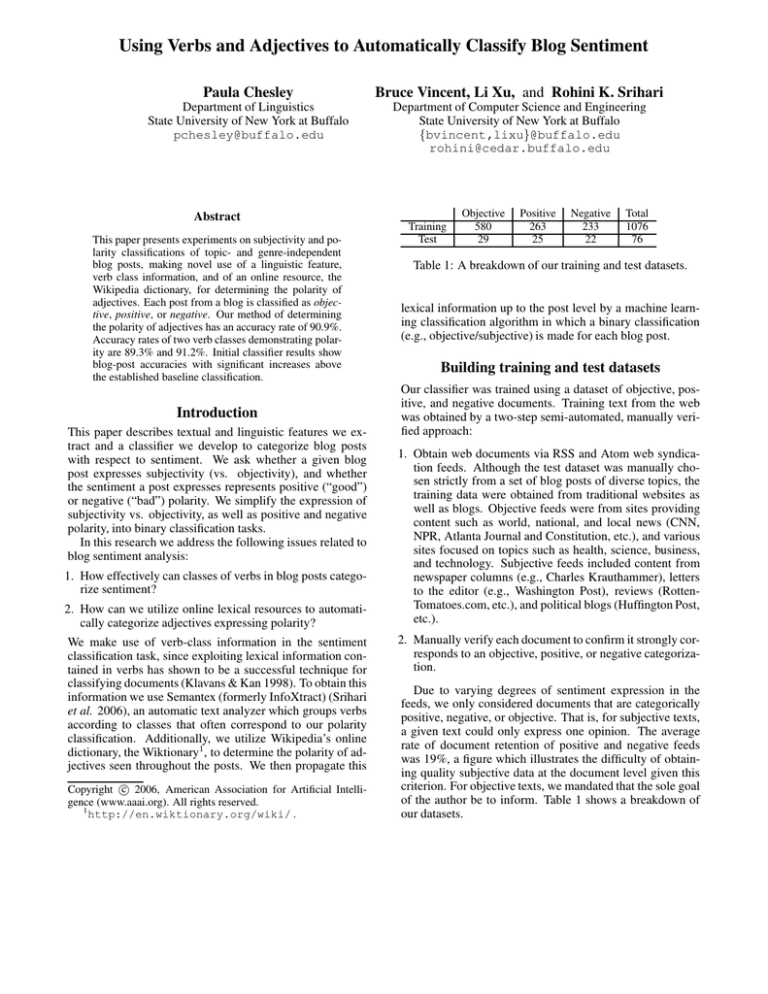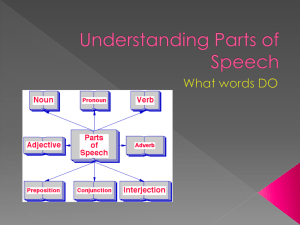
Using Verbs and Adjectives to Automatically Classify Blog Sentiment
Paula Chesley
Department of Linguistics
State University of New York at Buffalo
pchesley@buffalo.edu
Abstract
This paper presents experiments on subjectivity and polarity classifications of topic- and genre-independent
blog posts, making novel use of a linguistic feature,
verb class information, and of an online resource, the
Wikipedia dictionary, for determining the polarity of
adjectives. Each post from a blog is classified as objective, positive, or negative. Our method of determining
the polarity of adjectives has an accuracy rate of 90.9%.
Accuracy rates of two verb classes demonstrating polarity are 89.3% and 91.2%. Initial classifier results show
blog-post accuracies with significant increases above
the established baseline classification.
Introduction
This paper describes textual and linguistic features we extract and a classifier we develop to categorize blog posts
with respect to sentiment. We ask whether a given blog
post expresses subjectivity (vs. objectivity), and whether
the sentiment a post expresses represents positive (“good”)
or negative (“bad”) polarity. We simplify the expression of
subjectivity vs. objectivity, as well as positive and negative
polarity, into binary classification tasks.
In this research we address the following issues related to
blog sentiment analysis:
1. How effectively can classes of verbs in blog posts categorize sentiment?
2. How can we utilize online lexical resources to automatically categorize adjectives expressing polarity?
We make use of verb-class information in the sentiment
classification task, since exploiting lexical information contained in verbs has shown to be a successful technique for
classifying documents (Klavans & Kan 1998). To obtain this
information we use Semantex (formerly InfoXtract) (Srihari
et al. 2006), an automatic text analyzer which groups verbs
according to classes that often correspond to our polarity
classification. Additionally, we utilize Wikipedia’s online
dictionary, the Wiktionary1, to determine the polarity of adjectives seen throughout the posts. We then propagate this
c 2006, American Association for Artificial IntelliCopyright gence (www.aaai.org). All rights reserved.
1
http://en.wiktionary.org/wiki/ .
Bruce Vincent, Li Xu, and Rohini K. Srihari
Department of Computer Science and Engineering
State University of New York at Buffalo
{bvincent,lixu}@buffalo.edu
rohini@cedar.buffalo.edu
Training
Test
Objective
580
29
Positive
263
25
Negative
233
22
Total
1076
76
Table 1: A breakdown of our training and test datasets.
lexical information up to the post level by a machine learning classification algorithm in which a binary classification
(e.g., objective/subjective) is made for each blog post.
Building training and test datasets
Our classifier was trained using a dataset of objective, positive, and negative documents. Training text from the web
was obtained by a two-step semi-automated, manually verified approach:
1. Obtain web documents via RSS and Atom web syndication feeds. Although the test dataset was manually chosen strictly from a set of blog posts of diverse topics, the
training data were obtained from traditional websites as
well as blogs. Objective feeds were from sites providing
content such as world, national, and local news (CNN,
NPR, Atlanta Journal and Constitution, etc.), and various
sites focused on topics such as health, science, business,
and technology. Subjective feeds included content from
newspaper columns (e.g., Charles Krauthammer), letters
to the editor (e.g., Washington Post), reviews (RottenTomatoes.com, etc.), and political blogs (Huffington Post,
etc.).
2. Manually verify each document to confirm it strongly corresponds to an objective, positive, or negative categorization.
Due to varying degrees of sentiment expression in the
feeds, we only considered documents that are categorically
positive, negative, or objective. That is, for subjective texts,
a given text could only express one opinion. The average
rate of document retention of positive and negative feeds
was 19%, a figure which illustrates the difficulty of obtaining quality subjective data at the document level given this
criterion. For objective texts, we mandated that the sole goal
of the author be to inform. Table 1 shows a breakdown of
our datasets.
Due to the ironically subjective nature of what constitutes
subjectivity and polarity in a text, we carried out an agreement study on manual classification of our training dataset.
We checked the agreement of our two raters on 75 randomly
chosen documents in our training data, equally distributed
across positive, negative, and objective categories. Categorical inter-rater agreement for judging a document objective,
positive, or negative was K = .77. In our test set, we only
used blog posts that both raters marked as objective, positive, or negative.
Feature-based Classification
In this work we make use of several features of three principal types for our classification task: textual features (exclamation points and question marks), part-of-speech features,
and lexical semantic features. No part-of-speech features
showed an impact on the classifications; hence for reasons
of space we do not discuss them further. Each post is then
represented as a feature vector in an SVM classification.
The current work aims to tease out how verbs express sentiment in using the verb classes in Semantex. Our verb-class
information is often more fine-grained than the Levin verb
classes (Levin 1993) and can systematically incorporate polarity into a class. For example, approving verbs most often
show positive orientation, while doubting verbs tend to show
negative orientation. Hence we can capture sentiment expressed by statements like “I wholeheartedly support [Bush]
for the same reason I did when I wrote the above posts.”
Verbs such as agree and support are included in the approving verb class. Some verb classes, such as approving
and doubting verbs, are included to elicit sentiment polarity, while others, such as answering and suggesting verbs,
are meant to highlight subjective/objective factors. Table
3 lists the full set of verb classes used in the classification
task. These manually developed verb classes are discussed
in (Srihari et al. 2006) and (Li et al. 2003).
We use the online Wikipedia dictionary to determine the
polarity of adjectives in the text. The English Wiktionary
contains at least 96,054 entries (some entries actually being
for words in other languages), an amount that increases by at
least 3,000 entries per month2. A principal advantage of this
dictionary is its coarse-grained content: adjectives in this
resource are usually tersely defined, often by a list of synonyms. In brief, we find this resource similar to WordNet
with its concepts of glosses and synsets, but the Wiktionary
is not as specific. While (Hu & Liu 2004) yield positive results using WordNet for sentiment analysis, (Klavans & Kan
1998) note that their results are degraded by the ambiguity
and fastidious detail of verb synsets and that the same phenomenon occurs with nouns. Not wishing to overgenerate
adjective polarity where there is none, we see the Wikipedia
concept as ideal for determining adjective polarity.
Our Wiktionary method assumes that an adjective will
most likely have the same polarity as the words that define it.
We query the Wiktionary page for each adjective in a given
post, limiting our search to the adjectival portion of an entry,
2
http://en.wiktionary.org/wiki/Wiktionary:
Multilingual_statistics .
“lucky”
positive
negative
fortunate
–
good
–
good
–
good
–
fortunate
–
5>0
output: positive
Table 2: Classification of the polar adjective lucky using the
Wiktionary. The adjectives fortunate and good figure among
our list of manually constructed adjectives of positive polarity and were respectively seen two and three times in the adjective entry. Since our system recognizes more adjectives
of known positive polarity than of known negative polarity
for lucky, it classifies this adjective as positive.
modulo antonyms and example usages. This query looks for
the number of adjectives in two manually constructed lists of
known polarity in the entry. We count the number of adjectives of manually established polarity and assign the adjective in question the polarity of the majority of these found
adjectives. If an adjective of known polarity in the definition is negated (adjectival dictionary entries with negative
orientation are often defined in terms of a negated positive
adjective), we take its polarity to be the opposite of its established polarity. Table 2 shows an example classification
of an adjective using the Wiktionary.
The adjectives in our lists were chosen for their lack of
part-of-speech and polarity ambiguity. We have initially
opted for smaller lists of 34 adjectives for both positive and
negative polarities, a list size which can be changed in order
to maximize F-measures of adjective polarity. As for negation of polarity, in these first experiments we simply leave
out of the post’s sentiment classification any verb or adjective in a five-word window of a negation (within, of course,
the same sentence).
Each blog post is then represented as a vector with count
values for each feature in table 3. We then make a binary
classification for each post based on the score a Support Vector Machine (SVM) classifier assigns to a post. Our LIBSVM implementation3 gives the following binary classifications for all posts: objective/non-objective (i.e., subjective),
positive/non-positive, and negative/non-negative. The SVM
parameters are maximized for test accuracy.
Results
In the 76 test files there were a total of 3,460 adjective tokens and 836 adjective types. Of these 836 types 10.5%
were assigned a polarity by our program. We consider type
accuracy of our Wiktionary method to be the number of adjectives assigned a plausible polarity for that adjective, given
the Wiktionary entry for each adjective; this figure is 90.9%.
We then looked at two verb classes to see whether or not the
verbs in the class do represent the a priori polarity we had at3
http:www.csie.ntu.edu.tw/˜cjlin/libsvm .
Subjective vs. Objective Features
Objective Verb Classes
Textual Features
answering, asking,
exclamation points
asserting, explaining
question marks
Subjective Verb Classes
believing
suggesting
mental sensing
Polarity Features
Adjectives (Wiktionary)
Positive Verb Classes
positive adjectives
positive mental affecting,
negative adjectives
approving, praising
Negative Verb Classes
abusing, accusing, arguing, doubting,
negative mental affecting
Table 3: Features used in the sentiment classification task.
tributed them. Here accuracy is the number of verbs having
a primary sense expressing the a priori polarity; for doubting
verbs in our training data, accuracy is 89.3%. Accuracy on
positive mental affecting verbs is 91.2%.
The baseline accuracy for each post classification is
guessing the majority category, which is the opposite of the
category elicited. For example, in the positive/non-positive
classification we assume a post is either objective or negative, for a total of 51/76 posts, a 67.1% baseline. Table 4
shows that every classification using our textual and linguistic features yields results that represent a significant increase
above the baseline figures (paired t-test, all p < .01).
To get an idea of which individual features were contributing to the accuracy of our classifier, we experimented
in holding out each feature. Holding out a feature such as
the positive adjectives we obtained from the Wiktionary significantly decreases system accuracy, which implies that this
feature plays a large role in the correct classification of posts.
The effects of holding out individual features are given in table 4. Significant effects of holding out features on a given
classification task (paired t-test, all p < .01 except except
approving verbs, for which p = .013) are given in bold.
The hold-out experiments show initial results of what features prove useful in a given classification. For objective and
positive posts, positive adjectives acquired from Wikipedia’s
Wiktionary play a key role in increasing overall accuracy.
Thus our strategy for using an online dictionary in a sentiment classification task appears to have been successful.
The asserting and approving verb classes also contribute significantly to accuracy of the positive classification. These
results show that verb classes can improve results on sentiment classification of blogs. These preliminary findings
would also seem to indicate that we can substantially reduce
our feature space for the classification task.
The principal challenge remaining for us is classifying a
blog post for sentiment with the same high levels of accuracy
we obtain at the lexical level. In improving recall rates at the
lexical level, we aim to increase overall post-level accuracy:
while adjective accuracy in test data is high, the corresponding recall rates are low. Hopefully the high rate of lexical entries added monthly to the Wiktionary will help to improve
adjective recall, which will in turn increase accuracy at the
post level.
References
Hu, M., and Liu, B. 2004. Mining and Summarizing Customer Reviews. In Proceedings of the ACM SIGKDD In-
Held-out feature
Objective
All (baseline)
61.8%
None (system accuracy)
72.4%
exclamation points
69.7%
question marks
72.4%
answering verbs
72.4%
asking verbs
72.4%
asserting verbs
72.4%
explaining verbs
76.3%
believing verbs
72.4%
suggesting verbs
76.3%
mental sensing verbs
72.4%
positive mental affecting verbs
75%
approving verbs
73.7%
praising verbs
73.7%
abusing verbs
73.7%
accusing verbs
72.4%
arguing verbs
72.4%
doubting verbs
71.1%
negative mental affecting verbs
71.1%
positive adjectives
61.8%
negative adjectives
75%
Positive Negative
67.1%
71.1%
84.2%
80.3%
82.9%
80.3%
84.2%
80.3%
84.2%
80.3%
84.2%
80.3%
76.3%
80.3%
86.8%
80.3%
84.2%
80.3%
85.5%
80.3%
84.2%
80.3%
84.2%
80.3%
77.6%
80.3%
84.2%
81.6%
84.2 %
80.3%
84.2%
80.3%
81.6%
80.3%
84.2%
80.3%
82.9%
81.6%
67.2%
80.3%
82.8%
78.9%
Table 4: Effects of holding out an individual feature on accuracy, against system accuracy using all features. Verb classes
are grouped according to a priori subjectivity and polarity
judgements–e.g., positive mental affecting, approving, and
praising verbs all express positive polarity.
ternational Conference on Knowledge Discovery & Data
Mining, 168–177.
Klavans, J., and Kan, M. 1998. Role of Verbs in Document
Analysis. In Proceedings of the Conference COLING-ACL,
Montreal, 680–686.
Levin, B. 1993. English Verb Classes and Alternations. U.
Chicago Press.
Li, W.; Zhang, X.; Niu, C.; Jiang, Y.; and Srihari, R.
2003. An Expert Lexicon Approach to Identifying English
Phrasal Verbs. In Proceedings of ACL 2003, 513–520.
Srihari, R.; Li, W.; Niu, C.; and Cornell, T. 2006. InfoXtract: A Customizable Intermediate Level Information Extraction Engine. Journal of Natural Language Engineering
12:4.








